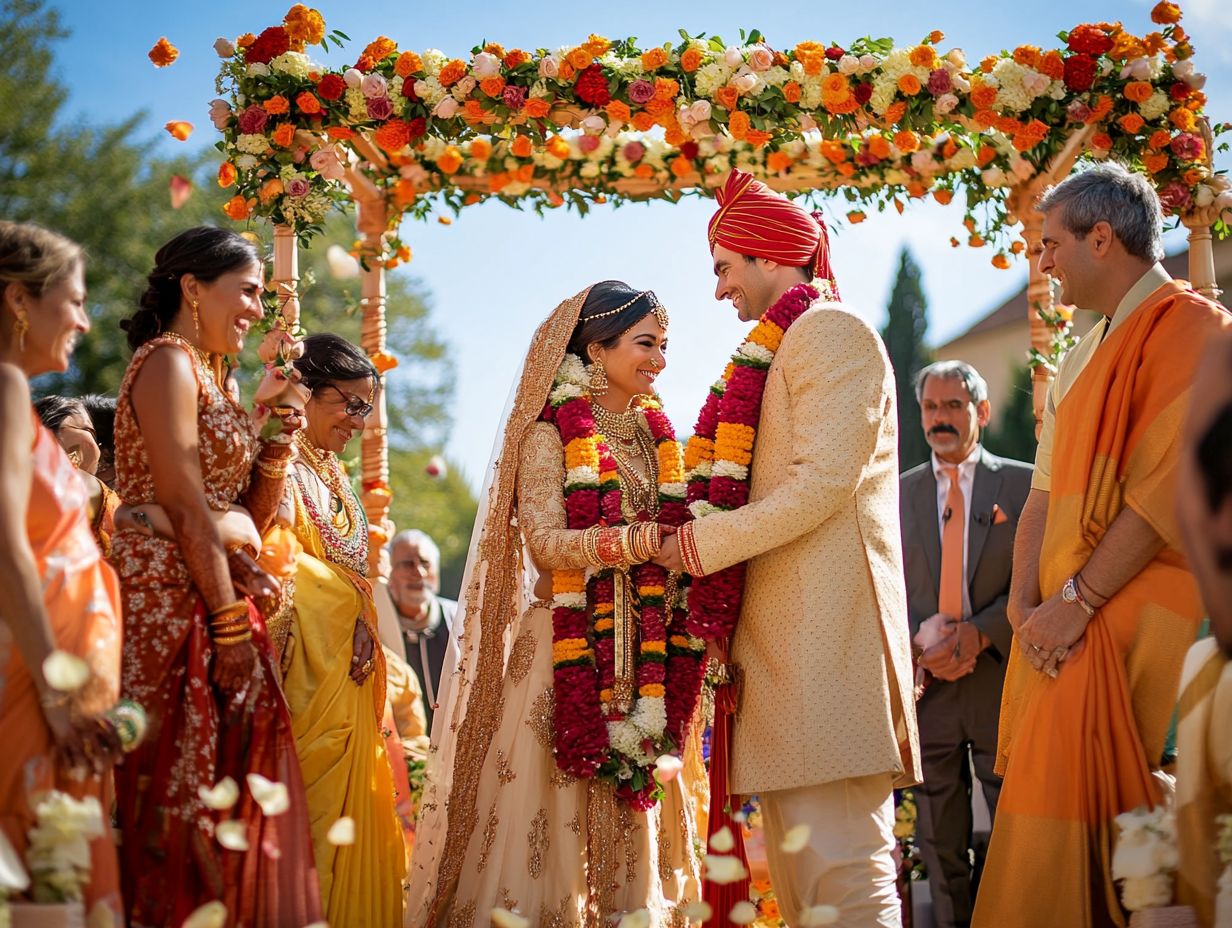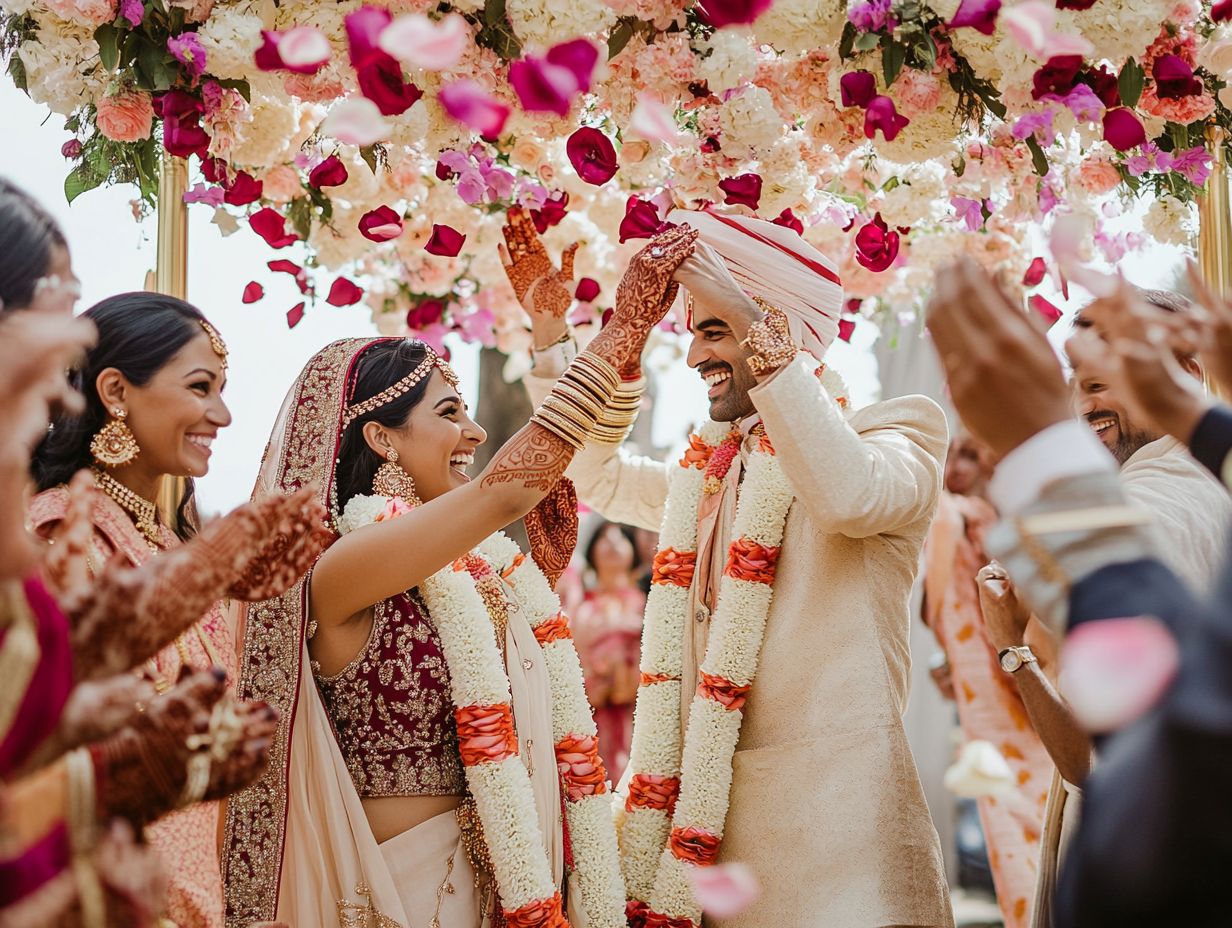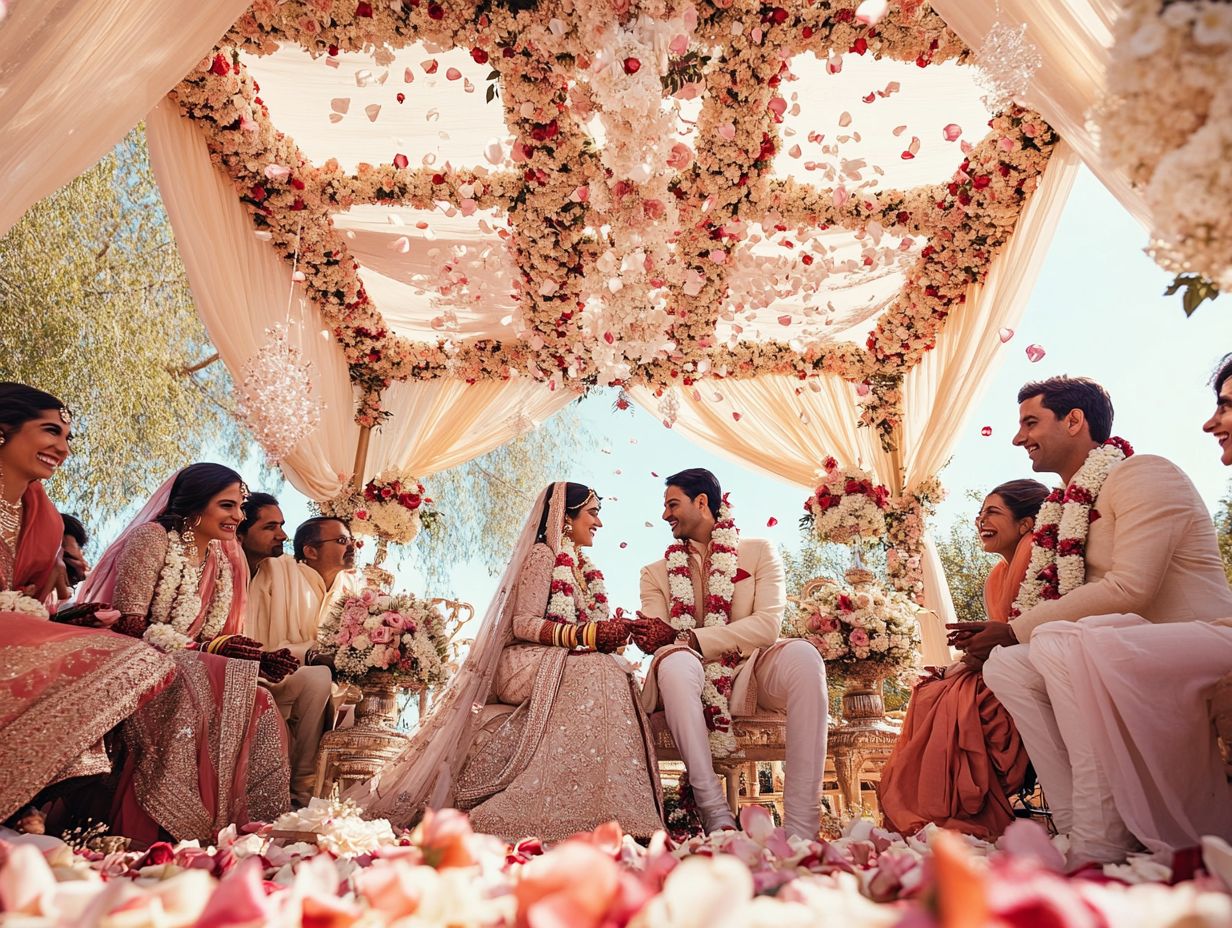What Are the Marriage Practices in Hinduism?
Marriage in Hinduism stands as a profound institution, deeply rooted in tradition, spirituality, and cultural significance. It is far more than merely a bond between two individuals; it represents a sacred commitment that intricately weaves together families and communities, reflecting cultural identity and spiritual union.
This article delves into the multifaceted purposes of marriage within Hinduism, exploring the various types of unions, essential rituals, and the significance of ceremonies that span from pre-wedding rituals to post-wedding customs.
Furthermore, it examines the challenges and adaptations encountered by modern Hindu marriages, providing valuable insights into the evolving nature of this time-honored practice, including changes in marriage practices and the role of matrimonial websites.
What is the Purpose of Hindu Marriage in Hinduism?

In Hinduism, the essence of marriage transcends the simple notion of companionship; it embodies a sacred union that intricately weaves together the lives of the bride and groom. This union is not only a source of emotional support but also a catalyst for spiritual growth and societal stability.
Engaging in diverse marriage practices, such as arranged marriage and love marriage, Hindu couples embark on a profound journey of marital bliss enriched by a tapestry of customs and rituals. Guided by Hindu scriptures and religious texts, this union fosters a deeply significant bond that enhances family dynamics and contributes to the overall well-being of the community.
What are the Different Types of Hindu Marriages?
Hindu marriages can be broadly classified into three categories: arranged marriages, love marriages, and inter-caste marriages. Each category reflects unique customs and societal expectations, with the involvement of parents and even matrimonial websites playing pivotal roles in the matchmaking process.
Arranged marriages are often viewed as a traditional and culturally endorsed practice, where family members select a partner based on criteria such as caste, social status, and economic stability. In this context, the union is not merely a pairing of individuals but a confluence of families and their respective values, often solidified through the acceptance of auspicious symbols and dowry practices.
On the other hand, love marriages prioritize personal choice and romantic affection. They enable couples to navigate their own journeys, even in the face of potential familial resistance. This shift towards individual agency marks a significant departure from conventional norms.
Inter-caste marriages add another layer of complexity to this narrative, as they challenge entrenched societal norms and ignite conversations surrounding caste hierarchy and acceptance. While both love and arranged marriages feature rituals and celebrations that underscore familial ties, the underlying motivations and expectations reveal profound cultural implications that significantly influence the lives of individuals within these unions. These unions often necessitate the involvement of a priest to perform Vedic rites and rituals of consent.
What are the Essential Elements of a Hindu Marriage?
The essential elements of a Hindu marriage encompass a rich tapestry of rituals and customs that elevate the sanctity of the ceremony. Among the pivotal components are Kanyadaan (Kanya Daan), Saptapadi (seven steps), wedding vows, and the tying of the Mangalsutra, each symbolizing the profound union of the bride and groom.
These traditions serve a dual purpose: they not only formally unite two individuals but also weave their families and communities into the fabric of the celebration. The Kanyadaan ceremony, in which the father bestows his daughter upon her spouse, signifies the relinquishing of parental duties and encapsulates an emotional moment filled with love and trust.
Following this poignant ritual, Saptapadi unfolds, consisting of seven sacred steps taken together, each representing a vow that the couple commits to uphold throughout their lives. This process fosters a deep sense of commitment, marital fidelity, and understanding between them.
The Mangalsutra, a sacred necklace, symbolizes the auspicious bond and protection shared by the couple; its tying marks the official commencement of their married life together, imbued with cultural significance and rich symbolic depth.
Pre-Wedding Rituals in Hindu Marriages
In Hindu marriages, pre-wedding rituals hold immense significance, serving as a vital foundation for the wedding ceremony itself. These elaborate traditions encompass a range of practices, such as the engagement ceremony, bridal makeup, the selection of wedding attire, and the distribution of the wedding invitation.
Each aspect is meticulously curated to resonate with familial values and aesthetics, enhancing the cultural richness of the event and setting an auspicious tone for the celebrations to follow, including rituals of sharing and family blessings.
What is the Role of Astrology in Hindu Marriages?
Astrology occupies a pivotal role in Hindu marriages, wherein horoscopes are meticulously scrutinized during the matchmaking process to assess compatibility and select an auspicious date, referred to as Shubh Muhurat, for the wedding ceremony. The alignment of celestial bodies is believed to influence the couple’s dharma and karma.
The alignment of celestial bodies at the moment of an individual’s birth is esteemed for its influence over personality traits and life choices, establishing astrological compatibility as a fundamental aspect of the selection process. This practice is deeply rooted in Hindu law and cultural significance.
Families frequently seek the expertise of skilled astrologers who evaluate the couples’ charts, searching for harmonious planetary alignments that indicate a balanced and prosperous union. This meticulous examination not only facilitates the anticipation of future challenges but also assists in determining the optimal wedding date, ensuring that the couple embarks on their marital journey under the most favorable cosmic conditions. Such practices underscore the religious rites and spiritual significance embedded in marriage traditions.
What is the Significance of the Engagement Ceremony?

The engagement ceremony in Hindu culture acts as a significant prelude to the wedding, symbolizing the formal commitment between the bride and groom while facilitating family involvement that showcases the rich cultural diversity and marriage customs across various regions of India. This ceremony often serves as an opportunity to exchange wedding gifts and blessings.
This momentous occasion not only heralds the beginning of a new chapter in the couple’s lives but also strengthens the bonds between their families, reinforcing shared values and traditions. During the engagement, rituals such as the exchange of rings and the receiving of blessings from elders take center stage, signifying the merging of two families and their collective support for the union, aligning with traditional vows and familial expectations.
These ceremonies are often marked by vibrant celebrations filled with music, dance, and traditional feasts, which highlight the joy and excitement surrounding the forthcoming marriage. The engagement serves as a bridge connecting the families, fostering unity and a shared hope for a harmonious future, setting the stage for a joyful wedding reception.
The Wedding Ceremony in Hindu Marriages
The wedding ceremony in Hindu marriages unfolds as a vivid tapestry of traditional rituals and customs, uniting the bride and groom in the presence of sacred fire. This powerful symbol signifies their enduring commitment to one another and the divine. It often includes sacred chants and the presence of household deities.
Each ritual, steeped in cultural richness and significance, adds layers of meaning to the celebration, transforming it into a profound and unforgettable experience.
What are the Traditional Rituals and Customs in a Hindu Wedding?
Traditional rituals and customs in a Hindu wedding encompass pivotal ceremonies such as Kanyadaan (Kanya Daan) and Saptapadi (seven steps), each embodying profound symbolic meanings that reaffirm the couple’s commitment and the familial bonds established during the celebration, often adorned in exquisite wedding attire.
The ritual of Kanyadaan, in which the bride s father bestows her upon the groom, symbolizes the transfer of responsibility and love, underscoring the significance of family in this sacred union. Simultaneously, Saptapadi entails the couple taking seven steps together, with each step representing a specific vow that underpins their lifelong partnership.
These rituals not only enhance the spiritual essence of the event but also fortify the connections between families, fostering a supportive and loving community around the newlyweds. Such ceremonies are deeply cherished, reflecting the rich tapestry of values and traditions that define Hindu culture, encompassing dharma, karma, and samskaras in their spiritual union.
What is the Importance of the Seven Vows in Hindu Marriages?
The Seven Vows, or Saptapadi, stand as a pivotal element of Hindu marriages, where the couple engages in solemn commitments that articulate their dedication to one another. These vows encompass a range of marital responsibilities and aspirations, setting the stage for a harmonious life together, adhering to the principles of marital harmony and sacredness.
More than a mere declaration of love, these vows establish the fundamental principles that will guide the couple throughout their shared journey. Each vow embodies a vital aspect of their relationship, emphasizing values such as mutual respect and loyalty, alongside promises of health and prosperity. For instance, the vow of companionship nurtures emotional support, creating an environment where both partners can flourish and uphold their marital duties.
The commitment to fidelity and partnership fortifies their foundation, ensuring they confront life’s challenges as a unified entity. By embracing these guiding principles, the couple not only deepens their bond but also fosters understanding, ultimately paving the way for a more fulfilling and enduring marriage, reflecting traditional vows and marriage symbolism.
Post-Wedding Rituals and Customs in Hindu Marriages
Post-wedding rituals and customs hold significant importance in Hindu marriages, with ceremonies like Grihapravesh symbolizing the bride’s entry into her new home. These rituals often include blessings from elder counsel, reflecting family values and social customs.
The wedding feast, in turn, serves not only as a celebration of familial bonds but also highlights community involvement, thereby reinforcing the established marital roles and cherished traditions within Hindu wedding culture. It often includes vibrant music, dance, and feasts that bring together family and friends.
What is the Significance of the Grihapravesh Ritual in Hindu Marriage?

Grihapravesh, the ritual that warmly welcomes the bride into her new home, carries profound significance in Hindu culture. It symbolizes a sacred transition into marital life and the establishment of a harmonious household imbued with love and respect. This ritual is one of the many customs that highlight the importance of marriage practices in Hinduism.
This ceremony not only heralds the beginning of a new chapter but also nurtures a sense of belonging and stability for the couple. The participation of both families underscores the merging of traditions and values, reinforcing the vital importance of unity in fostering marital happiness. It includes auspicious symbols and rituals of sharing, such as the sacred fire and family blessings.
Family members partake in various rituals, such as performing pooja and bestowing blessings upon the newlyweds, which serve to invoke divine guidance and protection for their shared journey. Each ritual embodies aspirations for prosperity, peace, and understanding within the marriage, thereby highlighting the communal and cultural threads that intricately bind families during this momentous occasion. This also includes rituals like Kanya Daan and the Saptapadi, or seven steps, which are essential parts of the Hindu marriage ceremony.
What are the Beliefs and Practices Related to the First Night of Marriage in Hinduism?
The first night of marriage, often enveloped in a tapestry of beliefs and practices, is regarded as a momentous occasion that signifies the couple’s transition into a shared life. Cultural beliefs intricately shape the rituals and family dynamics that govern intimacy on this special night. This night often starts with ceremonies involving sacred chants and the lighting of a sacred fire.
This transition embodies not merely a personal journey for the newlyweds, but also a reflection of the cultural values and expectations they inherit from their families and communities. Many cultures uphold the belief that this inaugural night establishes the foundation for the couple’s relationship, underscoring the significance of intimacy as both a physical and emotional bond. In Hinduism, this often involves traditional vows and the exchange of the Mangalsutra.
In certain traditions, specific rituals are prescribed, often involving symbolic acts or communal gatherings designed to honor heritage while nurturing a profound connection. These diverse practices illuminate how communities sustain traditions, artfully balancing modern influences with age-old expectations in the domain of marital intimacy. Such rituals of marriage and religious rites are deeply rooted in Hindu scriptures and religious texts.
What are the Challenges and Changes in Modern Hindu Marriages?
Contemporary Hindu marriages encounter a complex array of challenges, ranging from shifting marital roles and expectations to the profound effects of societal transformation. This evolving landscape has given rise to a growing necessity for marriage counseling and open dialogues about issues such as divorce in Hinduism, a subject that was once shrouded in taboo. Modern influences have also led to the rise of love marriages and the decline of strictly arranged marriages, reflecting changing attitudes towards partnership in Hindu culture.
What are the Common Issues Faced by Married Couples in Hinduism?
Married couples in Hinduism frequently face common issues that challenge the harmony of their union, such as marital fidelity, differing expectations, and the complexities of family dynamics. These factors necessitate a foundation of open communication and understanding. Couples often participate in marriage education programs to better navigate these challenges.
Cultural expectations and societal norms often amplify these challenges, imposing traditional roles within the marriage that can create significant pressure on partners to adhere to specific behaviors or duties. This pressure can lead to misunderstandings and feelings of resentment, complicating the marital landscape. The role of the groom and bride is often influenced by Hindu law and traditional social customs.
As couples navigate these intricacies, they may struggle to reconcile their individual desires with deeply ingrained cultural values, resulting in tension. By recognizing the importance of addressing these issues collaboratively, couples can cultivate an environment of respect and mutual support, ultimately strengthening their bond and fostering harmony within their relationship. The involvement of elder counsel and family lineage can also play a supportive role in resolving conflicts.
How has the Concept of Marriage Evolved in Modern Hindu Society?
The concept of marriage in contemporary Hindu society has undergone a remarkable transformation, shaped by a myriad of influences, including cultural integration, evolving marriage practices, and ongoing discourse surrounding issues like love jihad, all of which challenge traditional perspectives and norms. This evolution is also evident in the diverse pre-wedding rituals and post-wedding customs that have adapted over time.
As individuals increasingly embrace diverse cultural influences, a significant shift is apparent in the perception and execution of marriages. Globalization plays a pivotal role in this evolution, providing access to an array of ideas about partnerships that emphasize love and compatibility over conventional familial arrangements. The use of matrimonial websites for matchmaking is a modern development that reflects this shift.
This transformation has inspired many to consider inter-caste marriages, once deemed taboo, serving as a powerful statement against rigid societal structures. Additionally, changing gender roles have fostered more egalitarian partnerships, where responsibilities and decision-making are shared, prompting a redefinition of marital expectations that prioritizes personal happiness and mutual respect over traditional obligations. This modern outlook often blends with traditional festivals and celebrations to create a unique marital experience.
Frequently Asked Questions

What Are the Marriage Practices in Hinduism?
In Hinduism, marriage is considered a sacred union between two individuals and is an important aspect of life. The rituals of marriage often include the Kanya Daan, Saptapadi, and the exchange of the Mangalsutra.
What are the different types of marriage in Hinduism?
There are four main types of marriage in Hinduism: Brahma, Daiva, Arsha, and Prajapatya. Each type has its own specific rituals and customs.
What is the role of astrology in Hindu marriage?
In Hinduism, astrology plays a significant role in marriage as it is believed to determine the compatibility and auspiciousness of a couple. Horoscopes are often matched before a marriage is finalized. This practice is considered crucial in selecting auspicious dates for wedding ceremonies.
What is the significance of the wedding rituals in Hinduism?
The wedding rituals in Hinduism are not just ceremonial, but hold deep spiritual and symbolic meanings. They are believed to bring blessings, prosperity, and happiness to the couple’s married life. These rituals often involve the recitation of sacred chants and the lighting of the sacred fire, which are integral elements of the religious rites.
Can a Hindu marry someone from a different religion?
Yes, according to Hinduism, a person can marry someone from a different religion. However, certain customs and traditions may vary depending on the sect or community. Such marriages often involve a blend of religious rites and cultural significance from both faiths.
What is the role of the family in Hindu marriages?
In Hinduism, families play a significant role in arranging and conducting marriages. They are involved in finding suitable matches, negotiating dowry, and hosting elaborate wedding ceremonies. The family’s involvement underscores the importance of family tradition and community blessings in the success of the marriage.
